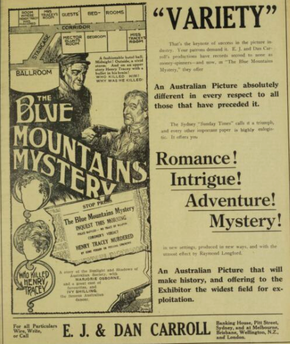Related Research Articles

The Blue Mountains Mystery is a lost 1921 Australian silent film directed by Raymond Longford and co-directed by Lottie Lyell.
Fellers is a 1930 Australian comedy about three friends in the Australian Light Horse during the Palestine Campaign of World War I starring Arthur Tauchert, who was the lead in The Sentimental Bloke (1919). The film is mostly silent with a recorded music score as an accompaniment, but the last reel was synchronised with a few minutes of dialogue and a song.

The Hayseeds is a 1933 Australian musical comedy from Beaumont Smith. It centres on the rural family, the Hayseeds, about whom Smith had previously made six silent films, starting with Our Friends, the Hayseeds (1917). He retired from directing in 1925 but decided to revive the series in the wake of the box office success of On Our Selection (1932). It was the first starring role in a movie for stage actor Cecil Kellaway.

The Assigned Servant is a 1911 Australian silent film about a convict who is transported to Van Diemen's Land. It was made by the husband-and-wife team of John and Agnes Gavin and is considered a lost film.

Sunrise is a 1927 Australian silent film co-directed by Raymond Longford, who took over during filming.
The Man They Could Not Hang is a 1934 Australian film directed by Raymond Longford about the life of John Babbacombe Lee, whose story had been filmed previously in 1912 and 1921.

The Enemy Within is a 1918 Australian silent film starring renowned Australian sportsman Snowy Baker in his first screen role.

The Jackeroo of Coolabong is a 1920 Australian silent film starring renowned Australian sportsman Snowy Baker. It was the last of three films he made with the husband and wife team of director Wilfred Lucas and writer Bess Meredyth, both of whom had been imported from Hollywood.

In the Nick of Time is a 1911 Australian silent film directed by Alfred Rolfe. It was described as a "sensational railway drama", although now is considered a lost film.

A Rough Passage is a 1922 Australian silent film directed by Franklyn Barrett based on the novel by Arthur Wright. It was Barrett's final feature and is considered a lost film.
The Tenth Straw is a 1926 Australian silent film heavily inspired by the novel For the Term of His Natural Life. Little is known of the director and cast, but most of the film survives today.
The Golden West is an Australian film directed by George Young set in the Australian goldfields. It is considered a lost film.
The Octoroon is an Australian film directed by George Young based on a popular play by Dion Boucicault which had recently enjoyed a popular run in Australia. It is considered a lost film.

The Price is a 1924 Australian silent film made with a largely amateur cast under the direction of Dunstan Webb. It is considered a lost film.

Dope is a 1924 Australian silent film about a respected citizen who is blackmailed by someone from his past. It is considered a lost film.

The Life Story of John Lee, or the Man They Could Not Hang is a 1912 Australian silent film based on a stage play about the true life story of John Babbacombe Lee.

The Life Story of John Lee, or the Man They Could Not Hang is a 1921 Australian silent film based on the true life story of John Babbacombe Lee. It is a remake of a 1912 film with some extra scenes of Lee's childhood.
The Australian Film Syndicate was a short lived Australian film production company based in North Sydney. According to novelist Arthur Wright, "A local draper put a lot of money into it, and lost it; though all the films produced were not 'duds.' One which paid its way well was an adaptation of my novel, Gamblers Gold."
Black Talbot is a 1911 Australian film from the Australian Film Syndicate who also made The Octoroon. It is a lost film.
Dr. Mawson in the Antarctic is a 1913 Australian documentary film by Frank Hurley about the Australasian Antarctic Expedition with Douglas Mawson.
References
- ↑ "Advertising". Newcastle Morning Herald and Miners' Advocate . No. 11, 621. New South Wales, Australia. 1 February 1912. p. 8. Retrieved 26 February 2024– via National Library of Australia.
- ↑ "C. Lacey Percival Resigns from A.F. Ltd.", Everyones., 5 (311 (17 February 1926)), Sydney: Everyones Ltd, nla.obj-574672185, retrieved 25 February 2024– via Trove
- ↑ "The Versatile Cameraman.", Everyones., 3 (158 (14 March 1923)), Sydney: Everyones Ltd, nla.obj-569876460, retrieved 26 February 2024– via Trove
- ↑ "Help the Orphans". The Gosford Times and Wyong District Advocate . Vol. XXIX, no. 134. New South Wales, Australia. 4 August 1911. p. 5. Retrieved 26 February 2024– via National Library of Australia.
- ↑ "Advertising". The Riverine Grazier . New South Wales, Australia. 8 December 1911. p. 2. Retrieved 26 February 2024– via National Library of Australia.
- ↑ "LOCAL NEWS". Singleton Argus . New South Wales, Australia. 23 November 1911. p. 2. Retrieved 26 February 2024– via National Library of Australia.
- ↑ "PICTORIA". The Maitland Daily Mercury . Vol. 7128, no. 5619. New South Wales, Australia. 20 January 1912. p. 2. Retrieved 26 February 2024– via National Library of Australia.